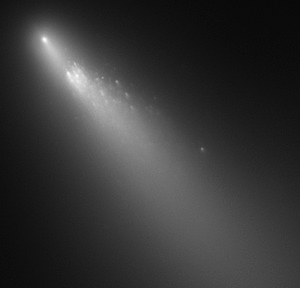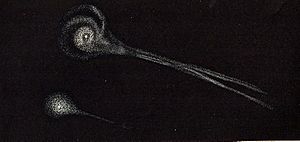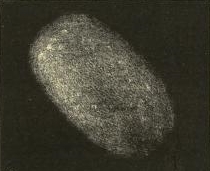Lost comet facts for kids
Imagine a comet that was seen once, but then vanished! A lost comet is a comet that astronomers expected to see again but couldn't find during its last trip around the Sun. This often happens if we don't have enough information to know exactly where it will be. It can also happen if the comet is too close to the Sun in the sky, making it hard to spot.
When a comet is officially considered "lost" or has disappeared, it gets a special "D/" in its name. Comets are a bit different from asteroids. Comets have icy cores that release gas, which can slightly change their path. This makes predicting their return a bit trickier. Some amazing astronomers, like Brian G. Marsden, are experts at finding these missing space travelers. He even helped predict the return of Comet Swift–Tuttle in 1992, which was once thought to be lost!
Contents
Why Comets Go Missing
Comets can disappear for several reasons. Sometimes, giant planets like Jupiter can pull on a comet with their gravity. This "pushes" the comet's path, changing when and where it will next appear. Also, the gas jets from a comet's icy core can act like tiny rocket engines, slightly altering its orbit.
Sometimes, a planet's pull can even kick a comet out of our Solar System entirely! This might have happened to Lexell's Comet. Other times, a faint comet might suddenly get much brighter, making it easy to spot. But after this "outburst," it might become too dim to see again.
Running Out of Steam
Comets are made of ice and dust. As they get closer to the Sun, the ice turns into gas. Over many trips, a comet can run out of this icy material. When that happens, it becomes a dark, rocky lump, much like an asteroid. We call this an extinct comet. This is likely what happened to 5D/Brorsen, which faded away in the late 1800s.

Breaking Apart
Sometimes, comets simply break into pieces. Biela's Comet is a famous example. It was seen splitting into two parts before it disappeared after 1852. More recently, 73P/Schwassmann–Wachmann has been observed breaking into many fragments since 1995.
Finding Lost Comets Again
Sometimes, a "new" comet turns out to be one that was lost long ago! Scientists can figure this out by carefully calculating its path and comparing it to old records. It's like finding a missing puzzle piece. This is a tough job for comets because their paths can change. For example, 177P/Barnard was first seen in 1889. It was then lost for 116 years before being found again in 2006!
Comets with Long Journeys
Not all comets that are out of sight are truly "lost." Some comets simply have very long orbits, meaning they take hundreds or even thousands of years to return! Thanks to powerful telescopes, we can now track these comets for much longer. For instance, Comet Hale–Bopp was visible to the eye for about 18 months after its visit in 1997. The amazing James Webb Space Telescope even saw Hale-Bopp in 2022, 25 years after its last close approach to the Sun!
Remember, comets that are officially lost or have disappeared get a "D/" at the start of their name.
Famous Lost and Found Comets
Comets are amazing travelers, but sometimes their journeys end unexpectedly, or they just take a very long time to come back! Here are a few interesting examples of comets that were lost, found, or had dramatic endings:
- D/1770 L1 (Lexell): This comet was likely kicked out of our Solar System after a close encounter with Jupiter in 1779. It's a good example of how giant planets can change a comet's path.
- 3D/Biela: This comet famously split into two pieces in 1846, and then into many more! It was last seen in 1852 and is now the source of the Andromedids meteor shower.
- 289P/Blanpain: Lost since its discovery in 1819 because it was so faint. It was rediscovered in 2003, first thought to be an asteroid, but then matched to the old comet! It's also linked to the Phoenicids meteor shower.
- 109P/Swift–Tuttle: This comet was lost for 130 years before being found again in 1992, exactly as predicted! It's famous for being the source of the annual Perseids meteor shower, which you might have seen.
- 73P/Schwassmann–Wachmann: This comet started breaking into many pieces in 1995 and even more in 2006. It created the Tau Herculids meteor shower.
- D/1993 F2 (Shoemaker–Levy): This comet had a very dramatic end! Its fragments crashed into Jupiter in 1994, giving scientists an incredible show and a chance to study a comet collision.
See also
- Brian G. Marsden, comet-orbit expert
- Extinct comet
- List of periodic comets
- List of non-periodic comets
- Lost asteroids
- Stanton A. Coblentz, author of The Lost Comet (1964)
- C/2019 Q4 (Borisov) (thought to be interstellar comet, disc. 2019)



